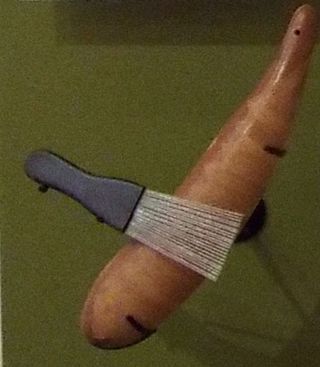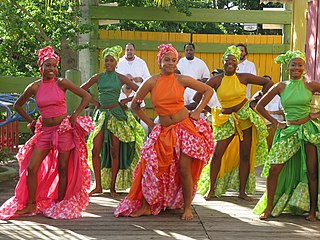Related Research Articles

Latin America is a cultural concept denoting the Americas where Romance languages—languages derived from Latin —are predominant. The term was coined in France in the mid-19th century to refer to regions in the Americas that were ruled by the Spanish, Portuguese, and French empires. The term does not have a precise definition, but it is "commonly used to describe South America, Central America, Mexico, and the islands of the Caribbean." In a narrow sense, it refers to Spanish America and Brazil. The term "Latin America" is broader than categories such as Hispanic America, which specifically refers to Spanish-speaking countries; and Ibero-America, a term not generally used that specifically refers to both Spanish and Portuguese-speaking countries while leaving French and British excolonies aside.

The population of Puerto Rico has been shaped by native American settlement, European colonization especially under the Spanish Empire, slavery and economic migration. Demographic features of the population of Puerto Rico include population density, ethnicity, education of the populace, health of the populace, economic status, religious affiliations and other aspects of the population.

The güiro is a percussion instrument consisting of an open-ended, hollow gourd with parallel notches cut in one side. It is played by rubbing a stick or tines along the notches to produce a ratchet sound.

Lehman College is a public college in New York City. Founded in 1931 as the Bronx campus of Hunter College, it became an independent college within CUNY in September 1967. The college is named after Herbert H. Lehman, a former New York governor, United States senator, philanthropist, and the son of Lehman Brothers co-founder Mayer Lehman. It is a senior college of the City University of New York (CUNY) and offers more than 90 undergraduate and graduate degree programs and specializations.
Afro–Latin Americans or Black Latin Americans are Latin Americans of full or mainly sub-Saharan African ancestry.

Sugar plantations in the Caribbean were a major part of the economy of the islands in the 18th, 19th, and 20th centuries. Most Caribbean islands were covered with sugar cane fields and mills for refining the crop. The main source of labor, until the abolition of chattel slavery, was enslaved Africans. After the abolition of slavery, indentured laborers from India, China, Portugal and other places were brought to the Caribbean to work in the sugar industry. These plantations produced 80 to 90 percent of the sugar consumed in Western Europe, later supplanted by European-grown sugar beet.
Latin Americans, sometimes referred to as Latinos, are the citizens of Latin American countries. Latin American countries and their diasporas are multi-ethnic and multi-racial. Latin Americans are a pan-ethnicity consisting of people of different ethnic and national backgrounds. As a result, some Latin Americans do not take their nationality as an ethnicity, but identify themselves with a combination of their nationality, ethnicity and their ancestral origins. Aside from the indigenous population, all Latin Americans have some Old World ancestors who arrived since 1492. Latin America has the largest diasporas of Spaniards, Portuguese, Africans, Italians, Lebanese and Japanese in the world. The region also has large German, French, Palestinian, Chinese and Jewish diasporas.

Matanzas is the capital of the Cuban province of Matanzas. Known for its poets, culture, and Afro-Cuban folklore, it is located on the northern shore of the island of Cuba, on the Bay of Matanzas, 90 kilometres (56 mi) east of the capital Havana and 32 kilometres (20 mi) west of the resort town of Varadero.
Afro-Caribbean people or African Caribbean are Caribbean people who trace their full or partial ancestry to sub-Saharan Africa. The majority of the modern African-Caribbeans descend from Africans taken as slaves to colonial Caribbean via the trans-Atlantic slave trade between the 15th and 19th centuries to work primarily on various sugar plantations and in domestic households. Other names for the ethnic group include Black Caribbean, Afro or Black West Indian or Afro or Black Antillean. The term Afro-Caribbean was not coined by Caribbean people themselves but was first used by European Americans in the late 1960s.

Slavery in the Spanish American colonies was an economic and social institution which existed throughout the Spanish Empire including Spain itself. In its American territories, early Spanish monarchs put forth laws against enslaving Indigenous peoples of the Americas. Queen Isabella outlawed the enslavement of Native Americans in the Spanish colonies of the New World because she viewed the natives as subjects of the Spanish monarchy. While Spain displayed an early abolitionist stance towards the Indigenous, some instances of illegal Native American slavery continued to be practiced by rogue individuals, particularly until the New Laws of 1543 which expressly prohibited it.
Latino studies is an academic discipline which studies the experience of people of Latin American ancestry in the United States. Closely related to other ethnic studies disciplines such as African-American studies, Asian American studies, and Native American studies, Latino studies critically examines the history, culture, politics, issues, sociology, spirituality (Indigenous) and experiences of Latino people. Drawing from numerous disciplines such as sociology, history, literature, political science, religious studies and gender studies, Latino studies scholars consider a variety of perspectives and employ diverse analytical tools in their work.
Sidney Wilfred Mintz was an American anthropologist best known for his studies of the Caribbean, creolization, and the anthropology of food. Mintz received his PhD at Columbia University in 1951 and conducted his primary fieldwork among sugar-cane workers in Puerto Rico. Later expanding his ethnographic research to Haiti and Jamaica, he produced historical and ethnographic studies of slavery and global capitalism, cultural hybridity, Caribbean peasants, and the political economy of food commodities. He taught for two decades at Yale University before helping to found the Anthropology Department at Johns Hopkins University, where he remained for the duration of his career. Mintz's history of sugar, Sweetness and Power, is considered one of the most influential publications in cultural anthropology and food studies.

Afro-Puerto Ricans are Puerto Ricans who are of Black African descent. The history of Puerto Ricans of African descent begins with free African men, known as libertos, who accompanied the Spanish Conquistadors in the invasion of the island. The Spaniards enslaved the Taínos, many of whom died as a result of new infectious diseases and the Spaniards' oppressive colonization efforts. Spain's royal government needed laborers and began to rely on African slavery to staff their mining and fort-building operations. The Crown authorized importing enslaved West Africans. As a result, the majority of the African peoples who entered Puerto Rico were the result of the Atlantic slave trade, and came from many different cultures and peoples of the African continent.
The mocambos were village-sized communities mainly of runaway slaves in colonial Brazil, during Portuguese rule.

The Caribbean is a subregion of the Americas that includes the Caribbean Sea and its islands, some of which are surrounded by the Caribbean Sea and some of which border both the Caribbean Sea and the North Atlantic Ocean; the nearby coastal areas on the mainland are often also included in the region. The region is southeast of the Gulf of Mexico and the North American mainland, east of Central America, and north of South America.
Caribbean immigration to New York City has been prevalent since the late 1800s and the early 1900s. This immigration wave has seen large numbers of people from Jamaica, Haiti, Cuba, Dominican Republic, Antigua and Barbuda, Guyana, and Trinidad and Tobago, among others, come to New York City in the 20th and 21st centuries. Caribbeans are concentrated in the Bronx, from 211th Street to 241st Street and Gun Hill Road. There are also Caribbean communities in Brooklyn, especially in the neighborhoods of Flatbush and Prospect Heights.

Blanqueamiento in Spanish, or branqueamento in Portuguese, is a social, political, and economic practice used in many post-colonial countries in the Americas and Oceania to "improve the race" towards a supposed ideal of whiteness. The term blanqueamiento is rooted in Latin America and is used more or less synonymously with racial whitening. However, blanqueamiento can be considered in both the symbolic and biological sense. Symbolically, blanqueamiento represents an ideology that emerged from legacies of European colonialism, described by Anibal Quijano's theory of coloniality of power, which caters to white dominance in social hierarchies. Biologically, blanqueamiento is the process of whitening by marrying a lighter-skinned individual to produce lighter-skinned offspring.

María de las Mercedes Barbudo was a Puerto Rican political activist, the first woman Independentista in the island, and a "Freedom Fighter". At the time, the Puerto Rican independence movement had ties with the Venezuelan rebels led by Simón Bolívar.

Slavery in Cuba was a portion of the larger Atlantic Slave Trade that primarily supported Spanish plantation owners engaged in the sugarcane trade. It was practised on the island of Cuba from the 16th century until it was abolished by Spanish royal decree on October 7, 1886.
The following is a timeline of the history of the city of Matanzas, Cuba.
References
- ↑ "Laird W. Bergad". cuny.edu. Retrieved November 29, 2016.
- 1 2 "Laird W. Bergad". cuny.edu. Retrieved November 29, 2016.
- 1 2 "Laird Bergad". lehman.edu. Retrieved November 29, 2016. Archived version.
- ↑ "Bergad, Laird W." worldcat.org. Retrieved November 29, 2016.
- ↑ "Laird W. Bergad". CLACLS. Retrieved 20 November 2018.